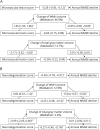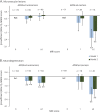MRI load of cerebral microvascular lesions and neurodegeneration, cognitive decline, and dementia
- PMID: 30232255
- PMCID: PMC6202944
- DOI: 10.1212/WNL.0000000000006355
MRI load of cerebral microvascular lesions and neurodegeneration, cognitive decline, and dementia
Abstract
Objective: To explore the differential associations of neurodegeneration and microvascular lesion load with cognitive decline and dementia in older people and the modifying effect of the APOE genotype on these associations.
Methods: A sample of 436 participants (age ≥ 60 years) was derived from the population-based Swedish National study on Aging and Care in Kungsholmen, Stockholm, and clinically examined at baseline (2001-2003) and 3 occasions during the 9-year follow-up. At baseline, we assessed microvascular lesion load using a summary score for MRI markers of lacunes, white matter hyperintensities (WMHs), and perivascular spaces and neurodegeneration load for markers of enlarged ventricles, smaller hippocampus, and smaller gray matter. We assessed cognitive function using the Mini-Mental State Examination (MMSE) test and diagnosed dementia following the Diagnostic and Statistical Manual of Mental Disorders, 4th edition criteria. We analyzed data using linear mixed-effects, mediation, and random-effects Cox models.
Results: During the follow-up, 46 participants were diagnosed with dementia. Per 1-point increase in microvascular lesion and neurodegeneration score (range 0-3) was associated with multiple adjusted β-coefficients of -0.35 (95% confidence interval, -0.51 to -0.20) and -0.44 (-0.56 to -0.32), respectively, for the MMSE score and multiple adjusted hazard ratios of 1.68 (1.12-2.51) and 2.35 (1.58-3.52), respectively, for dementia; carrying APOE ε4 reinforced the associations with MMSE decline. WMH volume changes during the follow-up mediated 66.9% and 12.7% of the total association of MMSE decline with the baseline microvascular score and neurodegeneration score, respectively.
Conclusions: Both cerebral microvascular lesion and neurodegeneration loads are strongly associated with cognitive decline and dementia. The cognitive decline due to microvascular lesions is exacerbated by APOE ε4 and is largely attributed to progression and development of microvascular lesions.
Copyright © 2018 The Author(s). Published by Wolters Kluwer Health, Inc. on behalf of the American Academy of Neurology.
Figures



References
-
- Qiu C, Fratiglioni L. A major role for cardiovascular burden in age-related cognitive decline. Nat Rev Cardiol 2015;12:267–277. - PubMed
Publication types
MeSH terms
Substances
LinkOut - more resources
Full Text Sources
Other Literature Sources
Medical
Miscellaneous
